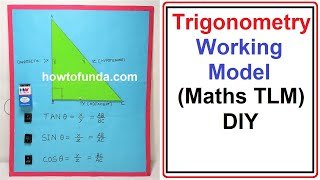In this project post we have explained you on how to make the trigonometry working model project – diy | maths TLM project
Creating a trigonometry working model using LED lights, a battery, and cardboard is an innovative way to visually understand trigonometric concepts.

In this model, we’ll use LED lights to represent angles and sides of a right-angled triangle. Here’s a step-by-step guide to making the model:
Materials you will need:
- Cardboard or a sturdy base
- Colored paper or markers (for decoration)
- LED lights (different colors, one for each angle and side of the triangle)
- Wires and connectors
- 9V battery or AA/AAA batteries with battery holder
- Battery snap connector or terminal connector
- Protractor (for measuring angles)
- Ruler
- Scissors
- Hot glue gun or adhesive putty (for securing components)
Step-by-step instructions:
- Design the base:
- Cut a large piece of cardboard or use a sturdy base to serve as the foundation for your trigonometry model.
- Decorate the base:
- Use colored paper or markers to decorate the cardboard base and make it visually appealing. You can draw markings for angle measurements, sides, and any trigonometric functions you wish to demonstrate.
- Determine the triangle:
- Decide on the dimensions of the right-angled triangle you want to represent in your model. You can use a ruler and protractor to draw and measure the triangle’s sides and angles on the cardboard.
- Attach the LED lights:
- Based on the dimensions of your triangle, determine the angles and sides you want to represent with LED lights. Drill or cut holes on the cardboard where you want to place the LED lights.
- Insert the LED lights into the holes from the backside of the cardboard so that the LED legs protrude through the front.
- Connect the LEDs:
- Connect the positive (longer) leg of each LED to the positive terminal of the battery snap connector using wires and connectors.
- Connect the negative (shorter) leg of each LED to its corresponding angle or side on the cardboard using wires and connectors.
- Connect the battery:
- Connect the battery snap connector or terminal connector to the battery.
- Connect the positive and negative terminals of the battery to the corresponding terminals on the battery snap connector or terminal connector.
- Test the Trigonometry Model:
- When the battery is connected, the LED lights representing angles and sides of the right-angled triangle should illuminate.
#trignometry #workingmodel #mathstlm #howtofunda #inspire #inspireaward
